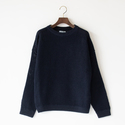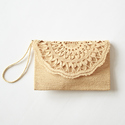- トップページ/
- Gifts by scene/
- Gifts with Noshi/
- TREASURE BOTTLE RED AND BLUE PAINTING FLOWERS AND BIRDS
TREASURE BOTTLE RED AND BLUE PAINTING FLOWERS AND BIRDS
utensils for the best tea
A teapot with no handle, Houhin. Maybe some of you are unfamiliar with it. The unique shape of Houhin was born from the fact that the handle is not necessary because hot water that can cause burns cannot be put into Houhin.
Delicious Japanese tea
The most important thing to enjoy delicious tea is "temperature". The temperature at which tea can be enjoyed most deliciously varies depending on the type of tea leaves, but it is said that the temperature at which sweet and umami-rich Japanese tea such as gyokuro and high-grade sencha can be enjoyed most deliciously is at a low temperature of about 50 to 70 degrees Celsius.
Pour the moderately cooled hot water into the Houhin containing the tea leaves to make the usual tea even more delicious. When brewing with hot water, take a short time, and when brewing with low-temperature water, take a long time to extract the umami efficiently. When it reaches a comfortable temperature that you can hold in your hand, pour it into hot water and enjoy a delicious tea.
Another good thing about Houhin. Since there is no handle, it is neat and convenient for storage. It's 230ml, enough for 2-3 people, and it's a size that's often used when you have guests over.
Houhin, which looks like a work of art, is recommended as a gift for those who want to enjoy tea in earnest. The colors are auspicious, making it a perfect gift for 60th birthday celebrations, housewarming celebrations, or for those looking for a new hobby.
The "Kayori" series, where you can enjoy a touch of tradition
This is the "Kayori" series from Nishikawa Teisaburo Shoten, which proposes new ways to enjoy Kiyomizu ware. You can find new ways to enjoy things by slightly modifying or combining things that have been handed down from ancient times. Such a playful spirit is one of the things that Kyoto has cultivated over its long history. Playfulness always adds glamor to people's lives and activities. Kayori, which was born by boldly incorporating Western colors and motifs in the painting, and combining traditional tea utensils in unexpected ways, has a fresh Kyoto glamor.
Aesthetics of Kyoto
Kiyomizu-yaki is one of Kyoto's representative traditional crafts, and it was originally called Kiyomizu-yaki, referring to the pottery that was fired in the Kiyomizu-zaka area on the way to Kiyomizu-dera Temple. While famous ceramics from various parts of Japan are made using the natural conditions of each region, such as soil and water, the aesthetic sense and culture of Kyoto, where people have gathered as the capital for over 1,000 years, has had an impact. It can be said that the feature is that it is a pottery that makes you feel the culture of wabi-sabi, which is unique to Japan.
Since Kyoto used to be the capital of Japan, it has long been a huge market where pottery from all over the country gathers as the center of Japan.
In the Momoyama period, along with the popularity of the tea ceremony, tea utensils and utensils began to be made in Kyoto, and they were presented to tea masters, imperial families, court nobles, feudal lords and temples in various places. Even now, there are more than 300 potteries.
Simple modern evolution
Established in 1917, Nishikawa Teisaburo Shoten, a long-established store that has been working to expand sales channels for Kiyomizu ware and daily necessities to Siberia and the South Sea Islands of China since around 1920, has been developing new products rooted in traditional Japanese culture. increase.
In modern times, it is not uncommon, but since its founding, it is a long-established manufacturer that has introduced Kiyomizu ware widely not only in Japan but also in Europe such as Paris and the Netherlands. Because of his achievements, he became the first chairman of the National Association of Small and Medium-Sized Trades in Kyoto, and left his name as one of the pioneers of the export of Kyoto traditional crafts. continues to be
The vessels made by Nishikawa Teisaburo Shoten are reminiscent of the beautiful scenery of Japan, and the concept of snow, moon, and flowers. I express playfulness with a vessel. While valuing the uniqueness of Japan, we also look overseas, simple and modern. At the same time, it is an emotional pottery that properly incorporates the aesthetic sensibility unique to Japanese people.
| Size | Width 11cm
Height 8.5cm Depth 10.5cm |
| Capacity | 230ml |
| Weight | 269g |
| Material | pottery |
| Country of origin | Japan |
| Gift box | This product would be packaged in a gift box. |
| Compatible devices | Microwave: ☓ Oven: ☓ Direct fire: ☓ Dishwasher: ☓ |
Feature of product
-
- The pottery may vary slightly in size, color, and shape, and there may be individual differences. This product is recommended for those who want to enjoy a warm texture that cannot be found in mass-produced products.
- This product is recommended for those who can understand the individuality of spots, glaze unevenness, shading, and shape distortion.
Notice
-
- Please note that it may be damaged by sudden temperature changes such as pouring boiling water or putting it on an open flame.
- Rubbing the bottom on a lacquer tray or lacquer table may cause scratches.
- Please refrain from rubbing strongly with cleanser or nylon scrubbers with abrasives.
- Avoid using pottery with overglaze, gold, or silver paint in a microwave oven or other high-temperature equipment. Doing so may cause the glaze to melt and the color painting to peel off.
ブランド紹介
NISHIKAWA TEIZABURO SHOTEN
Ancient city Kyoto is Gojo slope. NISHIKAWA TEIZABURO SHOTEN is located in the area where the pots of pottery and pottery are connected. Since its establishment in 1917, NISHIKAWA TEIZA BURO SHOTEN, which has been selling pottery and porcelain mainly from Kyoto and Shimizu, has been promoting sales of Shimizu and traditional handicrafts in the world, bringing Japanese traditional culture to the world It is a long-established store to introduce.
Kiyomizu-yaki is a pottery that has been around since the Edo period, and was burned in Gojozaka, which is an approach to Kiyomizu-dera Temple in Kyoto. After the Meiji era, pottery was actively made around Shimizu, and the way that Kyoto's pottery was called Shimizu-yaki was established.
It is one of the pottery that can be regarded as a symbol of Japanese culture that has received the designation of the traditional craft designated by the Minister of Economy, Trade and Industry and the traditional craft designated by the Kyoto Prefecture Governor.
| 商品 | 価格(税込) | 在庫 | 個数 | |
|---|---|---|---|---|

|
¥12,100(税込) |
△
残り2点 |
Added to cart
宝瓶 彩赤青絵花鳥には、他にもこんな仲間がいます
-
NISHIKAWA TEIZABURO SHOTEN
SAKE CUP SOKA AKIKUSA M SV GD¥14,300(税込)
-
NISHIKAWA TEIZABURO SHOTEN
PRIVATE MATCHA SET KUROYU SHIROTENMON¥49,500(税込)
-
NISHIKAWA TEIZABURO SHOTEN
TEACUP FUCHI SOMEAKA SANSUI¥13,200(税込)
-
NISHIKAWA TEIZABURO SHOTEN
RICE BOWL FUCHI SOMEAKA SANSUI¥15,400(税込)
-
NISHIKAWA TEIZABURO SHOTEN
MATCHA BOWL KOHAKU EDAUME¥7,150(税込)
-
NISHIKAWA TEIZABURO SHOTEN
MATCHA BOWL KOZANJI¥7,150(税込)
-
NISHIKAWA TEIZABURO SHOTEN
MATCHA BOWL MARGUERITE M SV¥11,000(税込)
-
NISHIKAWA TEIZABURO SHOTEN
MATCHA BOWL WHITE SAKURA¥11,000(税込)
-
NISHIKAWA TEIZABURO SHOTEN
CHOPSTICK RESTS GOURD SET OF 5¥4,400(税込)
-
NISHIKAWA TEIZABURO SHOTEN
PAIRED RICE BOWL MISHIMA¥6,600(税込)
-
NISHIKAWA TEIZABURO SHOTEN
COFFEE CUP SAKURA¥6,600(税込)
-
NISHIKAWA TEIZABURO SHOTEN
Green tea bowl Flower Shiragiku¥11,000(税込)
-
NISHIKAWA TEIZABURO SHOTEN
COFFEE CUP CAMELIA¥6,600(税込)
-
NISHIKAWA TEIZABURO SHOTEN
KIYOMIZU-YAKI TEACUP WILD FLOWERS¥7,150(税込)
-
NISHIKAWA TEIZABURO SHOTEN
KIYOMIZU-YAKI TEACUP AUTUMN PLANTS¥7,150(税込)
-
NISHIKAWA TEIZABURO SHOTEN
Green tea bowl Flower Tsubaki¥11,000(税込)
-
NISHIKAWA TEIZABURO SHOTEN
Green tea bowl Mishima¥6,600(税込)
-
NISHIKAWA TEIZABURO SHOTEN
Green tea bowl Black¥13,200(税込)
宝瓶 彩赤青絵花鳥を見た人はこんなアイテムも見ています
-
HAKUSAN PORCELAIN
G-type coffee cup and saucer 5 customer set¥21,450(税込)
-
NODA HORO
Porcelain Enamel Pot¥5,830(税込)
-
KOSEN
PAIRED NABESHIMA WARE TEACUP¥4,840(税込)
-
FALCON(ファルコン)
TEA POT¥9,020(税込)
-
Nankei porttery
TEAPOT SENCHA 320¥10,560(税込)
-
Blundstone(ブランドストーン)
BOOTS LOW CUT BS2039 BLACK¥28,600(税込)
-
KOSEN
Nabeshima Torasen Kiln Nabeshima Seigoku Donburi¥4,840(税込)
-
SHITSURINDO
CAN BE WASHED IN THE DISHWASHER ICHIJO URUSHI BOWL¥4,950〜(税込)
-
KUTANI CHOEMON
RICE BOWL WITH DYED SANSUIBUN¥8,140(税込)
-
HAKUSAN PORCELAIN
PAIR OF SHALLOW RICE BOWLS A19 D11¥6,600(税込)
-
IWACHU
Fried egg 3¥8,250(税込)
-
KUTANI CHOEMON
SIDE DISH FLOWER¥3,080〜(税込)
-
蔵珍窯(ぞうほうがま)
GOSUAKAE BOWL¥15,400(税込)
-
AIZAWA Wood Works
RINKA PLATE¥5,500〜(税込)























%20MILK.jpg)












.jpg)


































.jpg)










.jpg)

.jpg)






























































.jpg)
.jpg)



















